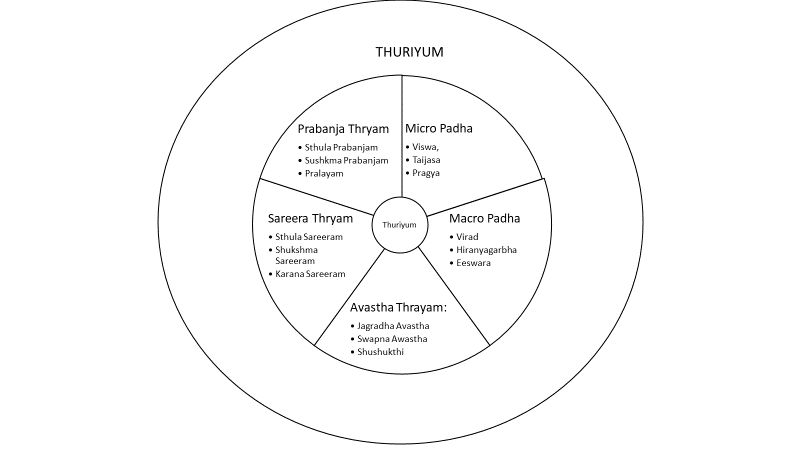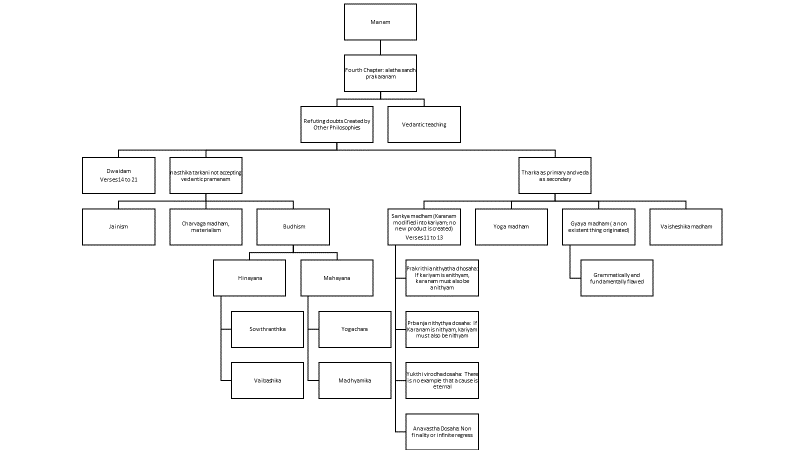Mandukya Upanishad, Class 56
Moksha is our very nature. Samsara exist only in the form of
misconception in the mind and has nothing to do with the external world.
Since the whole problem is in the form of misconception that I am bound, the
freedom is only freedom from this misconception. Freedom from any
misconception is possible only with the right knowledge. Vedanta helps us
in dropping the idea that I am bound. Dropping of the notion is
figuratively presented as attainment of freedom or moksha. This was summarized in up to the 10th
verse.
From 11 to 13 verses, Gowdapdha
points out four defects of Sankya philosophy.
- Prakrithi anithyatha dhosaha
- Prbanja nithythya dosaha
- Yukthi virodha dosaha: Argument against
reasoning; unreasonable argument. - Anavastha Dosaha: Non finality or infinite
regress
Verse 11 and 12 describe the first
two dosaha. In verse number 13, third and fourth dosha are
described. First line deals with third dosha and the second line deals
with the fourth dosha
Third dosha is that sankya
philosophers point out that prakrithi is the moola karanam or absolute cause of
the universe. The prakrithi is the cause of everything and that prkirthi
is anadhi or beginning less. It is not a product or karyam. It is a causeless cause. Gowdapadha
says this is illogical. Because any logical analysis is based on
experiential data; otherwise it will be speculative. When we look at the
creation the data, we collect is that every cause is effect. Parents are
cause but they are also effect; they have a beginning and ending; similarly
seed, tree etc. We do not see any karanam without beginning. Every
karanam is a kariyam with a beginning. Whatever karanam has a
beginning. Sankya philosophers say prakrithi is karanam but they also say
it is anadhi – without beginning. This is illogical. To prove this,
they must show at least one example which they can’t.
To avoid the problem in the third dosha,
let us say that they accept prakrithi as a product and has a beginning.
Then if prakrithi has a beginning then what is the cause of the
prakrithi. If there is a prakrithi before this prakrithi, then what is
the cause of this prakrithi. This will go on forever, and you will not be
able to arrive at the moola karanam. You will never be able to explain
the root cause of universe. If you can’t establish the cause, then you
can’t establish the effect; if you can’t establish the effect, you can’t
establish a product. If you can’t establish a product, then you can’t
establish creation. Creation implies cause and product. If you knock of creation, then it is
vedanta. There was, is and will be Brahman and that Brahman is you.
Creation is a notion and a misconception that should be dropped.
Verse 14
From this verse to 23rd verse,
Gowdapadha is refuting all forms of dwaida philosophy, where they accept
creation and take support from Veda. They are vaidhiga philosopher and
this philosophy is based on the vedas. They argue that there is a
creation. Gowdapadha wants to refute and establish there is no creation
at all. Ignorance solidified is creation. They depend up on theory of karma
to establish creation. In Vedanta, law of karma is provisional
answer, temporary concept to satisfy beginning students. Once the student
reaches maturity, it is replaced by no creation theory. Dwaida
philosophers offer law of karma as the ultimate answer. Gowdapadha
suggests of six options for moola karanam for dwaida philosophy and refutes
every one them. They say because of the karma (punyam and pavam) alone all
living beings are created. Karma is the reason for all jiva rasi or
sareeram. For the word karma Gowdapadha uses the word hethuhu and for
sareeram he uses the word palam. The six options by Gowdapadha are:
- Let us assume karma is the moola karanam of the universe.
If punya pavam is the moola karanam from where did the punyam and pavam
come? Punyam and pavam are generated out of karma and karma is generated
by kartha. So, option 1 is wrong. - Is sareeram is the moola karanam? Bagawan gives
bodies to everyone and with the body we produce karma. But if
Baghawan to give bodies to all jivas, what type of body would Bagawan
give? The type of body should be determined by karma. If
Bagawan gives good body to some and bad body to other then, that Bagavan
is partial. So sareeram can’t be
moola karanam. - Karma and sareeram are mutually cause and effect.
Karma is the cause of sareeram and sareeram is the cause of karma.
If two things have mutual cause effect relationship it is illogical
because if one is the cause it must be earlier in time and if two is the effect,
then it must be later in time. If they are mutually cause and
effect, then one must be earlier and then the other will be later.
It is like saying father has produced the son and the son has produced
father. This is not possible. - Karma and sareeram are simaltaneous products from which
the whole creation started. If Karma and sareeram are simultaneous,
they can’t have cause effect relationship. For example, twins can’t
have father son relationship. You will require some other cause for
karma and sareeram - It is in the form of cause effect chain. Karma 1
produces sareeram 1. Sareeram 1 produces karma 2. Karma 2
produces sareeram 2. Sareeram 2 produces karma 3. This is like
previous karma produced this body; and this body does not previous karma
but produces another set of karma. But this does not answer which
one is moola karanam. Whether the chain begins with karma or the
chain begins with sareeram. - This cause effect chain is anadhi. Creation is in
the form of karma sareeram chain, which is anadhi. There are several
defects in this theory.- When you say karma sareeram chain is anadhi, you are
using the adjective anadhi – beginningless. Now there are three
words: karma, sareeram and chain. When you add the adjective
beginningless does this adjective qualify karma, sareeram or chain.
Which one is beginningless? Karma, sareeram or chain. There
is no answer to that. Adjective can’t qualify karma because karma
is produced by sareeram. Adjective can’t qualify sareeram because
every sareeram has a beginning. If you say karma-sareeram chain or
flow is beginning less, there is no such thing called chain separate from
the individual. Other than guru and sishya there is no prambara; it
is only a concept. Similar to fruit salad. If you keep removing
all the fruits from the fruit salad, there is no such thing called
salad. It is a concept, not a thing. Family is a concept and
not a thing; there is no society other than indidivual. Therefore
the chain does not exist.
- When you say karma sareeram chain is anadhi, you are








